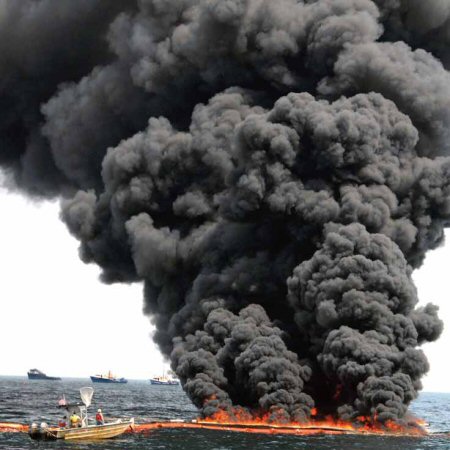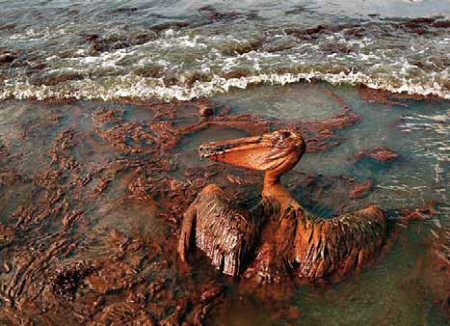SEJournal Online is the digital news magazine of the Society of Environmental Journalists. Learn more about SEJournal Online, including submission, subscription and advertising information.
Feature
By BOB THOMAS
Lessons from Gulf Oil Disaster: Everything from the social media’s importance to the need for a detailed disaster plan
 |
|
A Vessel of Opportunity boat stands by while oil is burned off during a controlled
in-situ burn on the waters of the Gulf of Mexico in mid-July. U.S. Air Force Photo by Tech. Sgt. Polly Bennett. |
In the aftermath of what has been billed as the greatest marine oil disaster in U.S. history, the media were expected to cover the issues quickly and in depth. I assumed there would be a rush for Pulitzers, with all major media, especially on the Gulf Coast, primed from their experiences during the Hurricane Katrina events.
But 2010 was different. Experience and the presence of a cast of excellent journalists were trumped by a devil absent during the Katrina coverage in 2005 — downsizing.
As an example, when the BP oil disaster began, The Times-Picayune in New Orleans had passed through a large buyout program and had a furlough system in place. The day the event occurred, Times-Picayune veteran environment writer Mark Schleifstein was on furlough and attending Jazz Fest. Since the event was sponsored by Shell Oil Company, Schleifstein immediately went to the Shell public relations people at the fest and queried them about covering such an oil disaster. While he was being schooled, funky music played in the background.
The Times-Picayune had also recently lost its person who specifically covers oil and gas.
Even so, it’s interesting to examine what other lessons, beyond the obvious dwindling of mainstream media, were learned from the BP oil disaster. We surveyed a variety of key journalists, scientists and others active in the disaster news coverage and its follow-up coverage:
Schleifstein and David Hammer, The Times-Picayune; Craig Pittman, St. Petersburg Times; Chris Kirkham, The Huffington Post (then with The Times-Picayune); Ben Raines, Mobile Press-Register; George Crozier, Dauphin Island Sea Lab; Nancy Rabalais, Louisiana Universities Marine Consortium; Ed Overton, Louisiana State University; Aaron Viles, Gulf Restoration Network; and Jill Mastrototaro, Sierra Club.
Here’s our lessons learned:
1. We must be careful making comparisons among oil spills in different regions. Early reports compared Ixtoc, the Exxon Valdez and Deepwater Horizon. Now much has been written about the differences among the three (including types of oil, ecosystems, proximity to the coast, etc.).
2. Everyone wants to be on the cutting edge of breaking news, but when the disaster is of a highly technical nature, one often has to step back and dig deeper. Understanding the issues and conveying correct information is more important than being first.
3. Having a catastrophic emergency management plan is of paramount importance for all media. The Times-Picayune had been through Katrina, but still does not have a plan. Schleifstein says that once an emergency management plan is developed and accepted, senior executives and editors must meet every six months or so to review the document.
4. We were again reminded of the impact of social media, bloggers and those who comment on media websites. Many bloggers did yeoman’s work reporting and analyzing oiling events. But there were plenty who had strong agendas and tended to feed distrust and controversy. Virtually all stories published online were followed by accusatory commentary by unidentified writers.
5. BP and federal agencies immediately had a presence on social networks, especially Twitter and Facebook, and this became a real aid to reporters. Photos with notes, tags, and commentary posted on Flickr allowed reporters to know who was doing what and where.
6. Press conferences are vital sources of information, but under emergency conditions they can be vexing. Federal agencies attempted by strategy or just by defensiveness to put so many people on the scene that reporters were overwhelmed by press conferences. It was often impossible to attend them all (one in Baton Rouge, another in Grand Isle, an overlap with Venice, followed by a telephone conference), and it was also difficult to step back and consider the information presented.
Throughout the BP event, there were many telephone briefings. Journalists found it hard to get questions in and follow-ups were usually not allowed. Questions were cut off by moderators who were not on the scene so journalists could not ask for clarifications. There simply must be a better system in the future.
7. Surface oil collection was largely inadequate. Aaron Viles, Gulf Restoration Network, maintains that the oil industry appeared willing to gamble with their procedures and lacked response preparation.
Skimmers were not as effective as the companies believed them to be. BP spokespersons made early claims that they could skim 500,000 barrels of oily water per day, but as of July 6, 2010, 78 days after the incident, they had actually only skimmed a total of 670,000 barrels — some 37 million barrels below the promise. Reporters covering the issue came to realize that oil boom does not work in Gulf waters. Enormous resources were used to deploy boom, and it usually washed ashore, out to sea, or was otherwise rendered useless.
Ben Raines of the Mobile Press-Register found that there was no fire boom available along the Gulf Coast, in spite of a 1994 federal agency plan that pre-approved pulling the trigger to burn surface oil in the event of an oil catastrophe. Fire boom was supposed to be staged along the coast, at a rather modest cost (for the oil industry) of several hundred thousand dollars each.
Industry also did not improve its methods for resolving blowouts between 1979 (Ixtoc) and 2010 (Deepwater Horizon). As Rachel Maddow pointed out, the two blowouts in the Gulf of Mexico generally followed similar sequences of attempted solutions, both resulting in prolonged failure.
8. Most reporters did not understand what they needed to look for ecologically — up and down the food chain.
9. The complicated technical aspects of the explosion and progression of corrective attempts underscored the importance of being on the site of breaking news. This was not a time for superficial reporting, and a reporter’s lack of diligent work to understand the issues was readily apparent. The Times-Picayune’s David Hammer did not consider himself an environmental or oil reporter, but he was excellent on complicated issues. He says one of the most important steps he took was to make several visits to oil rigs and platforms, experiencing the actual workplace, procedures, overall operational concerns faced by workers each day. It gave him valuable insights into the progression of events on the rig over the Macondo Well.
10. A reporter’s expert pool changes from issue to issue: The BP blowout was so specialized that the usual broad-based experts were of less value. This disaster was out of everyone’s depth, and reporters had to be very focused to communicate the information clearly.
11. The responsible party (in this case BP), as defined by the Oil Pollution Act of 1990, has power that controls the flow of information and the gathering of the story. The Coast Guard deferred to BP (stopped air traffic, access to beaches, boat movement), and federal agencies’ policies were often misleading, such as the long delay before the gusher video feed was made public.
12. People must learn to recognize residual risk and how to address it. Schleifstein of The Times-Picayune often mentions the dire need to get ahead of the game in high-stakes situations (for example the offshore oil industry, hurricane protection levees, nuclear power, and more) and address risks that are not so obvious, the high-stakes risk of failures that are not expected to occur. He asks if the BP calamity was a result of not producing stories about residual risks in advance.
(And speaking of risk, reporters must be aware of personal dangers they face when they are in the field covering risky issues, such as chemical spills.)
13. Reporters need to be aware that individual states have their own agendas that affect the game. During the BP spill, Alabama officials were very concerned about closing channels on their barrier islands that were opened by Katrina. Louisiana was focused on getting financial help to rebuild its coast, so officials promoted moving sand from offshore to build berms and using rocks to close inlets into Barataria Bay.
 |
|
In early June, a heavily oiled pelican struggles on an island beach in
Barataria Bay, Louisiana. Photo by Carolyn Cole / Los Angeles Times. |
14. Public officials in general did not always understand the ecological issues. Politicians were front and center in the news, but most did not grasp the technical aspects and characteristically focused on their parochial needs instead of the big picture.
15. It is important to know the actual record of oil spills prior to an emergency. Oil releases are routine in the Gulf oil fields, so people ignore them until a catastrophic event occurs. Certainly, the Deepwater Horizon gusher contributed well above the normal oil contamination experienced in the Gulf, but the Mississippi River daily transports mega-amounts of hydrocarbons to the Gulf sourcing from oil on land that is washed into rivers. Andy Revkin noted a few years back that a study by the American Petroleum Institute showed that in the Chesapeake Bay area, hydrocarbons equaling the Exxon Valdez spill reach coastal waters each year, originating from the drops that fall from a gasoline nozzle in gas stations and oil on the streets from leaks in cars.
Schleifstein reported that during the initial 104 days of the spill, BP sprayed 140 thousand pounds of dispersants per day. He further discussed that this daily amount is equivalent to the surfactants that are delivered to the Gulf each day by the Mississippi River.
16. It is easy for journalists, especially if on a solo assignment on an unfamiliar topic, to be sucked into innuendo and anecdotal information. Big stories like the BP oil blowout may be ripe with hoaxes perpetuated by an array of stakeholders. Trust your investigative journalistic training and instincts.
17. Although events may have horrible consequences, reporters need to cover stories of good things being done by the responsible parties. Most reporting on the BP blowout discussed the obvious environmental threats, damage, and challenges. In addition to damage to the environment, economy, and coastal culture, BP stepped up quickly, making money available for restoration of community losses. They put $20 billion in escrow for such purposes, $1 billion for immediate restoration, and $500 million for ecological assessment research. These and related measures, for the most part, were reported rather passively. People close to the process knew that BP was not forced to take those steps, and saw them as positive goodwill on the part of the company.
Before the Deepwater Horizon, Gulf Coast reporters, for the most part, considered themselves prepared to cover oil releases. If heeded, these lessons learned from an event well beyond the routine — America’s largest oil release in a marine environment — could help make journalists wiser and more prepared for the future.
Robert A. Thomas, Professor and Director, Center for Environmental Communication, School of Mass Communication, Loyola University, New Orleans, Louisiana 70118. He can be reached at rathomas@loyno.edu.
* From the quarterly newsletter SEJournal, Summer 2011 issue.












 Advertisement
Advertisement 



